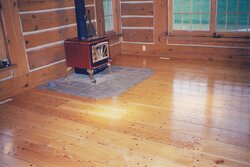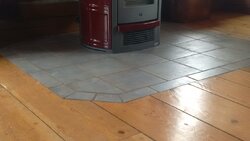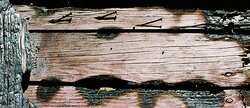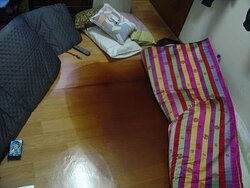Advice on designing hearth flush to floor
- Thread starter Moorboy3
- Start date
-
Active since 1995, Hearth.com is THE place on the internet for free information and advice about wood stoves, pellet stoves and other energy saving equipment.
We strive to provide opinions, articles, discussions and history related to Hearth Products and in a more general sense, energy issues.
We promote the EFFICIENT, RESPONSIBLE, CLEAN and SAFE use of all fuels, whether renewable or fossil.
You are using an out of date browser. It may not display this or other websites correctly.
You should upgrade or use an alternative browser.
You should upgrade or use an alternative browser.
- Status
- Not open for further replies.
It's in the manual for each stove.
Floor protection
Floor protection under the Jøtul F 3, must be one of the following:
1. Any non combustible material with an insulative R value of 1.1.
The F500 is ember protection only unless installed in an alcove
Floor protection
Floor protection under the Jøtul F 3, must be one of the following:
1. Any non combustible material with an insulative R value of 1.1.
The F500 is ember protection only unless installed in an alcove
goofa
Burning Hunk
Oslo, page 7
Floor Protection
Floor protection under the stove must be constructed of a non- combustible material for protection from radiant heat, sparks, and embers.
Individual sections of floor protection must be mortared together to prevent sparks from falling through to combustible materials. Any carpeting must be removed from under the floor protection.
Castine, page 6
The Jøtul F 400 requires one of the following three forms of hearth protection:
Floor Protection
Floor protection under the stove must be constructed of a non- combustible material for protection from radiant heat, sparks, and embers.
Individual sections of floor protection must be mortared together to prevent sparks from falling through to combustible materials. Any carpeting must be removed from under the floor protection.
Castine, page 6
The Jøtul F 400 requires one of the following three forms of hearth protection:
- Any UL, ULC or WH listed hearth board. (No bottom heat shield required).
- Any noncombustible material that has a minimum R- value of 2.0. (No bottom heat shield required.)
- Any noncombustible material with the use of the stove’s bottom heat shield.
goofa
Burning Hunk
Ok sorry I was only looking at the Oslo I guess. Oops but it does not specify an R value correct? Just something to protect from embers is that correct in my understanding ?
2. describes the R value if there is no bottom heat shield.
if there is a bottom heat shield then 3. ember protection only.
if there is a bottom heat shield then 3. ember protection only.
goofa
Burning Hunk
So basically if I want to build a 12" raised hearth for an Oslo out o 2x materials and just cap it with any type of cement board.....hardie board, durarock,etc...... and tile or stone or concrete over that it is fine because a specific r value need not be met ?
goofa
Burning Hunk
Yes I see the numerical list as you have quoted in the castine manual but nothing of the likes for the Oslo just ember protection
The Oslo is ember protection only, unless installed in an alcove.
Floor protection under the stove must be constructed of a non- combustible material for protection from radiant heat, sparks, and embers.
page 7 for alcove installation
Floor protection under the stove must be constructed of a non- combustible material for protection from radiant heat, sparks, and embers.
page 7 for alcove installation
- The bottom heatshield is required in all alcove installations.
- If a listed (UL/ULC) hearth board is not used the hearth
that is constructed must have a minimum r value of 1.6 (see
appendix a).
goofa
Burning Hunk
skinanbones
Feeling the Heat
Begreen I had a moment here at work and did a little digging in my copy of the CSA B365-10. The general overview of section 8.1 Floor protection state that except when otherwise certified each appliance shall have ember protection and radiant heat protection in accordance with the requirements of clause 8.1.3 and 8.1.4
Section 8.1.3 deals with ember protection and states that all stoves shall be protected by a continuous durable noncombustible pad that provides ember protection. The code defines durable as a metal sheet with a thickness of 0.38" or a grouted noncombustible tile on a solid surface.
Section 8.1.4 deals with radiant heat protection and it only applys to units that the firebox is at or closer than 7" and it requires either a course of hollow bricks or custom heat shield to provide the needed protection. This section of the code when you get into the WETT reference manual is just to deal with uncertified stove ( cookstoves in particular )
There's quite a bit more legalise that I don't feel like typing out but this is the overall feel of the text in referring to ember and radiant protection.
Section 8.1.3 deals with ember protection and states that all stoves shall be protected by a continuous durable noncombustible pad that provides ember protection. The code defines durable as a metal sheet with a thickness of 0.38" or a grouted noncombustible tile on a solid surface.
Section 8.1.4 deals with radiant heat protection and it only applys to units that the firebox is at or closer than 7" and it requires either a course of hollow bricks or custom heat shield to provide the needed protection. This section of the code when you get into the WETT reference manual is just to deal with uncertified stove ( cookstoves in particular )
There's quite a bit more legalise that I don't feel like typing out but this is the overall feel of the text in referring to ember and radiant protection.
Just a preference, but I would raise the hearth up a few inches and overhang your finished edge to give it a toe-kick. I did this with mine, and I really appreciate it for a number of reasons. When you sweep off your hearth, it makes it a lot easier to hold a dustpan under the lip than to chase that little line of ash and debris around like you will with a flush hearth. Second, if your knees and back are as old as mine, any amount you can raise up your stove to keep from bending and stooping is a good thing. Third, to my eye, it just looks better.
To get my R rating, I sandwiched creteboard and micore, topped it with a limestone slab. I will second the caution about not ever skimping on your R value. I found out that my limestone hearth doesn't even get warm to the touch under my Jotul, but I did it like the specs called for. Even though it was more time and effort, not to mention $, I don't regret that one bit. The specs are obviously over-engineered, and I don't fault Jotul for that at all. Don't mess around with something like this, for all the obvious reasons. Peace of mind is probably the biggest one.
To get my R rating, I sandwiched creteboard and micore, topped it with a limestone slab. I will second the caution about not ever skimping on your R value. I found out that my limestone hearth doesn't even get warm to the touch under my Jotul, but I did it like the specs called for. Even though it was more time and effort, not to mention $, I don't regret that one bit. The specs are obviously over-engineered, and I don't fault Jotul for that at all. Don't mess around with something like this, for all the obvious reasons. Peace of mind is probably the biggest one.
solarstar
Member
Last edited:
Begreen I had a moment here at work and did a little digging in my copy of the CSA B365-10. The general overview of section 8.1 Floor protection state that except when otherwise certified each appliance shall have ember protection and radiant heat protection in accordance with the requirements of clause 8.1.3 and 8.1.4
Section 8.1.3 deals with ember protection and states that all stoves shall be protected by a continuous durable noncombustible pad that provides ember protection. The code defines durable as a metal sheet with a thickness of 0.38" or a grouted noncombustible tile on a solid surface.
Section 8.1.4 deals with radiant heat protection and it only applys to units that the firebox is at or closer than 7" and it requires either a course of hollow bricks or custom heat shield to provide the needed protection. This section of the code when you get into the WETT reference manual is just to deal with uncertified stove ( cookstoves in particular )
There's quite a bit more legalise that I don't feel like typing out but this is the overall feel of the text in referring to ember and radiant protection.
That sounds similar to US code. It establishes a minimum ember protection usually with metal or tile covered millboard, except when otherwise certified (by the manufacturer). To my knowledge the hearth requirement is greater than ember protection in Canada for stoves whose manufactures specify a higher R value hearth requirement as certified by testing. For example, there is no special Canadian spec or optional bottom heat shield for this stove that has an R=2.0 hearth requirement:
http://www.canadiantire.ca/en/pdp/t...e-1800-sq-ft-e-p-a-0642812p.html#.Uzw_EdyIQpE
Only a fool would build or recommend building something not by the book when the results can so easily be deadly. None of us know how much extra margin for safety any of the minimum specifications has as extra. I cheat on plenty of stuff, but only where the results of failure wont kill anybody.
Agreed , someone like yourself should probably stick to the exact specs as shown by the manufacturer...Some of us do have practical field experience and from this experience have gained a certain amount of knowledge and common sense that allows us to design and modify things to meet our particular needs...if you look around a little you will see that many wood stoves are safely installed over Hearths that do not meet the exact 1.1 R value...even in this thread there is an example....again its probably better someone like yourself does not attempt to think outside the box, but for some of us it is Ok...For the heck of it I sent an Email to Jotul in SCANDANAVIA. Our exchange was regarding the F-3.....1 1/2" of concrete over a combustible surface is OK for the F-3... Might not be the exact 1.1 R value but Mr Odmund from Jotul said it would be fine....
Unless you got a written and signed document from them modifying the specs you need to stick with the printed and approved specs. If you do not you do not meet code if an inspector knows what they are looking for you will fail. You also are risking any insurance claim having to do with the stove or chimney being denied due to improper installation. Not to mention that you could burn the house down. I don't care what experience you have you still need to follow the specs that is what my many years of in the field experience have taught me.
No problemJ good Luck. .Sendt: 3. april 2014 14:22 Til: Skjønsholt Oddmund Emne: Re: SV: F-3 wood stove question Thankyou for the quick response .......would 1-1/2" of concrete be a suitable surface to install the F3 on? Thanks... ____________________________________________________________
The format got a little screwed up during the Copy and paste..my question is at the bottom, MR Oddmund from Jotul responded Above....No problem Good luck....
The format got a little screwed up during the Copy and paste..my question is at the bottom, MR Oddmund from Jotul responded Above....No problem Good luck....
Ok who is mr oddmund? Is he an engineer and did he test that before replying? does he have the authorization from his superiors to make that modification? and did they then run it by the independent testing facility that approved the original spec?
Unless you got a written and signed document from them modifying the specs you need to stick with the printed and approved specs. If you do not you do not meet code if an inspector knows what they are looking for you will fail. You also are risking any insurance claim having to do with the stove or chimney being denied due to improper installation. Not to mention that you could burn the house down. I don't care what experience you have you still need to follow the specs that is what my many years of in the field experience have taught me.
The original conversation was not about insurance companies and inspectors....Thousand of people install wood stoves every year without the involvement of insurance companies and inspectors...the OP simply asked for suggestions on how to accomplish something...I maintain that my original Approach would be safe and also meet the OPs needs, Jotul confirmed what I already now...If the conversation had been about inspectors and insurance my advice would have been different...
Ok who is mr oddmund? Is he an engineer and did he test that before replying? does he have the authorization from his superiors to make that modification?
Not sure, I will now begin a full investigation to find out the Jotul Guys Title in the company and his posistion in the company
 !
! 
Look, at the end of the day everyone has to do what they are comfortable with....I know what works for me does not work for everyone....Have a good night....
Last edited by a moderator:
Grisu
Minister of Fire
if you look around a little you will see that many wood stoves are safely installed over Hearths that do not meet the exact 1.1 R value
They are not safely installed, they may not have led to any accidents so far (at least to your knowledge; I am wondering how many dead people are posting here that being skimpy on the hearth requirements was NOT the best thing to do.)
- Status
- Not open for further replies.
Similar threads
- Replies
- 3
- Views
- 426
- Replies
- 0
- Views
- 779
- Replies
- 0
- Views
- 456
- Replies
- 1
- Views
- 987





